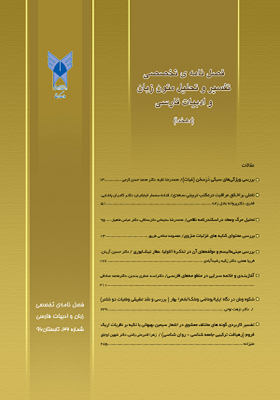تحلیل مرگ و معاد در اسکندرنامه نظامی
محورهای موضوعی : متون زبان و ادبیات فارسیمحمدرضا سلیمانی دلارستاقی 1 , عباس ماهیار 2
1 - دبیر- آموزش و پرورش
2 - استاد گروه ادبیّات فارسی دانشگاه آزاد اسلامی واحد کرج، کرج،ایران
کلید واژه:
چکیده مقاله :
اعتقاد به روز رستاخیز ، شالودة فکری نظامی را تشکیل میدهد . نگرش حکیم گنجه دربارة دنیا و آخرت و پیوستگی این دو با هم ، او را از دیگر شاعران پیش از خود متمایز ساخته است . این نوشتار میکوشد تا سیمای مرگ را در کتاب اسکندرنامه، بر اساس آیات و قرآن و احادیث و دیگر کتب دینی بررسی کند و ارتباط آن را با مقولاتی چون دین ، دنیا و معاد دریابد .نظامـی ضمن اشراف بر فلسفة اسلاف و عقایـد آنها ، سعـی دارد به تبییـن مباحثـی بپردازد که با اندیشههای اسلامی پیوندی دیرینه دارد. ضرورت وجود عالم دیگر، میل به بقا و جاودانگی ، نامیرایی روح ، ناپایداری دنیا، بازگشت به اصل ، معاد جسمانی و امثال آن، از جمله مسائلی است که در این جستار مورد ارزیابی قرار گرفته است . در این مقاله، ابتدا مباحث یاد شده به شیوه کتابخانهای بررسی شده و سپس به روش تحلیلی-توصیفی به نگارش در آمده است.
Nezami’s belief in the Day of Resurrection forms the basis for his thoughts. His attitude towards the existing world and the afterworld as well as the cohesion between the two makes him different from his predecessor poets. With reference to Quranic verses and Islamic traditions and texts the present paper is to study and review the aspects of “death” in Eskandarnameh in order to find the relationship between the “death” and the religion, the present world and the afterworld. Having a taste and discernment of his predecessors’ philosophy and ideas, Nezami has tried on interpretation and explanation of those very ideas that are in deep relation with Islamic thoughts. This research has been mainly concerned with such notions as the being of the afterworld as a sine qua non, tendency to survival and eternity, immortality of spirit , insubstantiality of life, returning to the genesis, bodily Ascension, etc. After embarking on a library-based research, the article seeks, in due course, to study and analyze the subject matter.
_||_

